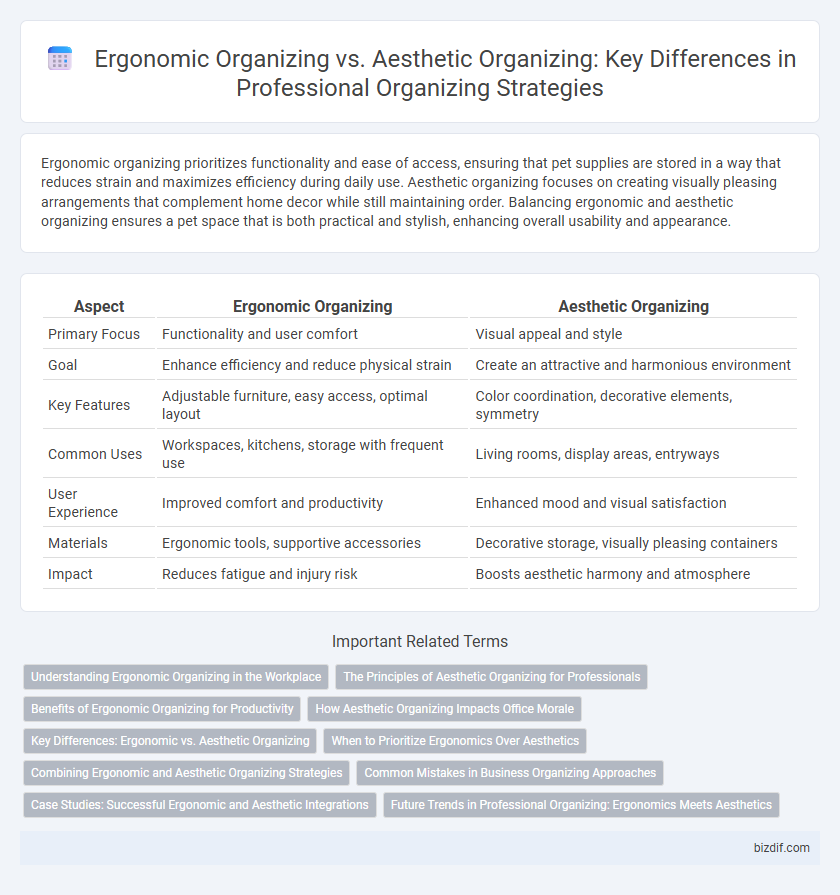Ergonomic organizing prioritizes functionality and ease of access, ensuring that pet supplies are stored in a way that reduces strain and maximizes efficiency during daily use. Aesthetic organizing focuses on creating visually pleasing arrangements that complement home decor while still maintaining order. Balancing ergonomic and aesthetic organizing ensures a pet space that is both practical and stylish, enhancing overall usability and appearance.
Table of Comparison
| Aspect | Ergonomic Organizing | Aesthetic Organizing |
|---|---|---|
| Primary Focus | Functionality and user comfort | Visual appeal and style |
| Goal | Enhance efficiency and reduce physical strain | Create an attractive and harmonious environment |
| Key Features | Adjustable furniture, easy access, optimal layout | Color coordination, decorative elements, symmetry |
| Common Uses | Workspaces, kitchens, storage with frequent use | Living rooms, display areas, entryways |
| User Experience | Improved comfort and productivity | Enhanced mood and visual satisfaction |
| Materials | Ergonomic tools, supportive accessories | Decorative storage, visually pleasing containers |
| Impact | Reduces fatigue and injury risk | Boosts aesthetic harmony and atmosphere |
Understanding Ergonomic Organizing in the Workplace
Ergonomic organizing in the workplace prioritizes optimizing the arrangement of tools, furniture, and workflow to reduce physical strain and enhance employee productivity. This approach leverages ergonomic principles such as proper desk height, adjustable chairs, and accessible storage solutions to prevent repetitive stress injuries and improve comfort. Unlike aesthetic organizing, which emphasizes visual appeal, ergonomic organizing focuses on functionality and health benefits to create a sustainable and efficient work environment.
The Principles of Aesthetic Organizing for Professionals
Aesthetic organizing emphasizes visual harmony, balance, and the intentional arrangement of items to create a pleasing environment that enhances productivity and well-being. Professionals apply principles such as color coordination, symmetry, and minimalism to transform spaces into functional yet inviting areas that reflect personal or brand identity. Prioritizing aesthetic organizing boosts motivation and reduces stress by fostering a sense of order and beauty in the workspace.
Benefits of Ergonomic Organizing for Productivity
Ergonomic organizing enhances productivity by designing workspaces that reduce physical strain and improve accessibility, allowing for efficient task completion without discomfort. Incorporating adjustable furniture, strategically placed tools, and clutter-free environments minimizes distractions and fatigue, leading to increased focus and energy levels. These benefits translate into faster work processes, reduced risk of injury, and sustained productivity over long periods.
How Aesthetic Organizing Impacts Office Morale
Aesthetic organizing enhances office morale by creating visually pleasing and inspiring workspaces that boost employee satisfaction and productivity. Incorporating color psychology, personalized decor, and harmonious layouts fosters a positive and motivating environment. Studies show that aesthetically organized offices reduce stress levels and encourage creativity, directly impacting team engagement and overall workplace well-being.
Key Differences: Ergonomic vs. Aesthetic Organizing
Ergonomic organizing prioritizes functionality and efficiency by arranging items to enhance ease of access, minimize physical strain, and improve workflow. Aesthetic organizing focuses on visual appeal, using color coordination, symmetry, and decorative elements to create a pleasing environment. The key difference lies in ergonomic organizing optimizing for user comfort and practical use, while aesthetic organizing emphasizes design and style.
When to Prioritize Ergonomics Over Aesthetics
Prioritize ergonomic organizing over aesthetic organizing when functionality and user comfort directly impact productivity and health, such as in workspaces or areas used frequently. Ergonomic setups reduce physical strain and enhance efficiency by optimizing reach, posture, and movement, making them essential for long-term use environments. Aesthetic considerations can complement but should not compromise ergonomic standards in spaces requiring sustained interaction and physical activity.
Combining Ergonomic and Aesthetic Organizing Strategies
Combining ergonomic and aesthetic organizing strategies enhances both functionality and visual appeal, creating spaces that improve efficiency while pleasing the eye. Ergonomic organizing focuses on optimizing layout and accessibility to reduce strain, while aesthetic organizing prioritizes harmonious design and style elements. Integrating these approaches results in environments that support well-being and productivity without sacrificing elegance.
Common Mistakes in Business Organizing Approaches
Common mistakes in business organizing approaches include prioritizing aesthetic organizing over ergonomic organizing, which can lead to visually pleasing but inefficient workspaces. Failing to consider ergonomic principles often results in reduced productivity and increased employee discomfort or injury. Effective professional organizing balances functional layout with appealing design to optimize workplace performance and well-being.
Case Studies: Successful Ergonomic and Aesthetic Integrations
Case studies demonstrate that ergonomic organizing significantly enhances productivity by tailoring space layouts to physical comfort and efficiency, as seen in corporate offices reducing employee strain and improving workflow. Aesthetic organizing emphasizes visual harmony and style, proven in high-end retail environments where captivating design boosts customer engagement and brand perception. Successful integrations balance ergonomic principles with aesthetic appeal, exemplified in collaborative workspaces that maximize usability while maintaining an inviting atmosphere conducive to creativity.
Future Trends in Professional Organizing: Ergonomics Meets Aesthetics
Future trends in professional organizing emphasize the integration of ergonomic principles with aesthetic design to create spaces that enhance productivity and well-being. Ergonomic organizing focuses on optimizing physical comfort and reducing strain through strategic placement and accessibility, while aesthetic organizing prioritizes visual harmony and style to foster positive environments. Combining these approaches results in functional, attractive spaces that support both efficiency and mental clarity.
ergonomic organizing vs aesthetic organizing Infographic

 bizdif.com
bizdif.com